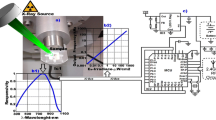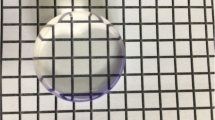Abstract
Several studies have demonstrated that polycarbonate-based polymers have good capacities for the absorption of 222Rn. Meanwhile, polystyrene polymers are reported to be the most appropriate for developing plastic scintillator materials for the detection of radioactivity. The objective of this work was to develop plastic scintillators in the form of microspheres (PSm) composed of polystyrene and polycarbonate that could be used to measure 222Rn and improve this performance thanks to the combination of characteristics of both polymers. Our results show that PSm of polystyrene and polycarbonate can be made via the evaporation/extraction method, despite the two polymers not being miscible. From the point of view of the radioactive measurements, we observed that the addition of polycarbonate causes quenching, although it does not significantly affect the detection efficiency for alpha and high-energy beta emitters. From the point of view of 222Rn absorption, we observed that synthesis of the PSm through the evaporation/extraction method changes the 222Rn absorption of the raw material. This result demonstrates that the method of production of the polymer and the resulting physical characteristics are a key parameter for its final 222Rn absorption properties.









Similar content being viewed by others
References
International Atomic Energy Agency (2012) Protection of the public against exposure indoors due to natural sources of radiation. 112
WHO (2009) WHO handbook on indoor radon—a public health perspective. World Health Organization, Geneva
Gorchev HG, Ozolins G (2011) WHO guidelines for drinking-water quality. WHO Chron 38:104–108
The Council of the European Union (2013) Council Directive 2013/51/Euratom of 22 October 2013 laying down requirements for the protection of the health of the general public with regard to radioactive substances in water intended for human consumption. Off J Eur Union 296:12–21
L’Annunziata MF (2013) Handbook of Radioactivity Analisis. Academic Press, San Diego
Pressyanov D, Dimitrova I, Mitev K, Georgiev S (2012) Handbook of radon: properties, applications, and health. Nova Science Publishers, New York
Mitev K, Zhivkova V, Pressyanov D et al (2014) Liquid scintillation counting of polycarbonates: a sensitive technique for measurement of activity concentration of some radioactive noble gases. Appl Radiat Isot 93:87–95
Santiago LM, Tarancón A, García JF (2016) Influence of preparation parameters on the synthesis of plastic scintillation microspheres and evaluation of sample preparation. Adv Powder Technol 27:1309–1317
Tarancon A, García JF, Rauret G (2002) Mixed waste reduction in radioactivity determination by using plastic scintillators. Anal Chim Acta 463:125–134
Mitev K, Dimitrova I, Tarancón A et al (2016) Pilot study of the application of plastic scintillation microspheres to Rn-222 detection and measurement. IEEE Trans Nucl Sci 63:1209–1217
Pressyanov D, Mitev K, Georgiev S et al (2017) Laboratory facility to create reference radon + thoron atmosphere under dynamic exposure conditions. J Environ Radioact 166:181–187
Santiago LM, Bagán H, Tarancón A, Garcia JF (2013) Synthesis of plastic scintillation microspheres: evaluation of scintillators. Nucl Instrum Methods Phys Res Sect A 698:106–116
Pressyanov D, Mitev K, Georgiev S, Dimitrova I (2009) Sorption and desorption of radioactive noble gases in polycarbonates. Nucl Instrum Methods Phys Res Sect A 598:620–627
Mitev K, Cassette P, Georgiev S et al (2016) Determination of 222Rn absorption properties of polycarbonate foils by liquid scintillation counting. Application to 222Rn measurements. Appl Radiat Isot 109:270–275
Ghorbel E, Hadriche I, Casalino G, Masmoudi N (2014) Characterization of thermo-mechanical and fracture behaviors of thermoplastic polymers. Materials (Basel) 7:375–398
Santiago LM, Bagán H, Tarancón A et al (2013) Systematic study of particle quenching in organic scintillators. Nucl Instrum Methods Phys Res Sect A 698:26–36
Acknowledgements
We thank the Spanish Ministerio de Economia y Competitividad (MINECO) for financial support, under award CTM2014-02020 and the Catalan Agència de Gestió d’Ajuts Universitaris i de Recerca (AGAUR) for financial support under award 2014-SGR-1277. This work was also supported in part by the Bulgarian National Science Fund under contract DFNI T02/13 “POLYRAD”. The authors thank Tatiana Boshkova for performing the gamma spectrometry measurements and Philippe Cassette for suggesting the counting geometry for the LSC measurements of 222Rn.
Author information
Authors and Affiliations
Corresponding author
Electronic supplementary material
Below is the link to the electronic supplementary material.
Rights and permissions
About this article
Cite this article
Pelay, E., Tarancón, A., Mitev, K. et al. Synthesis and characterisation of scintillating microspheres made of polystyrene/polycarbonate for 222Rn measurements. J Radioanal Nucl Chem 314, 637–649 (2017). https://doi.org/10.1007/s10967-017-5488-3
Received:
Published:
Issue Date:
DOI: https://doi.org/10.1007/s10967-017-5488-3




